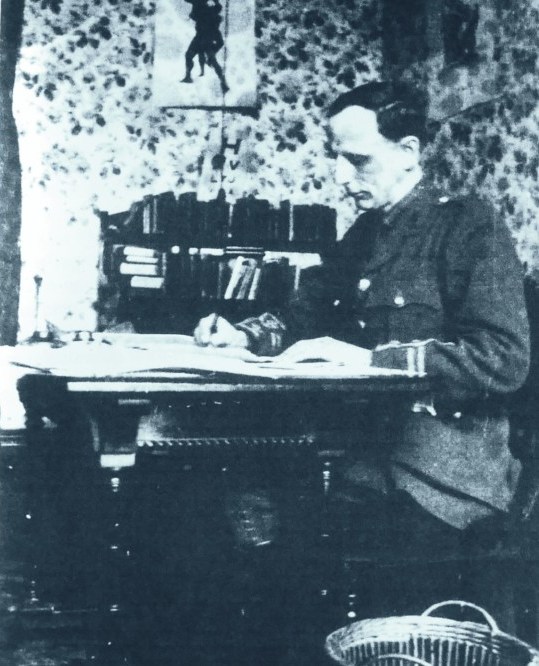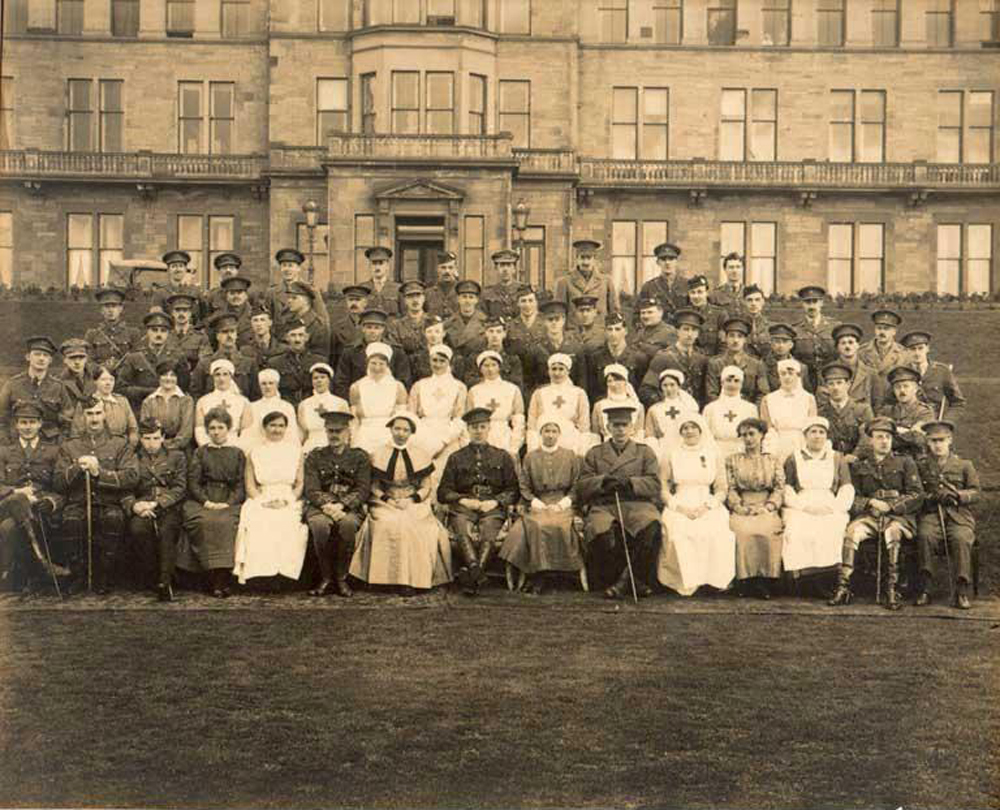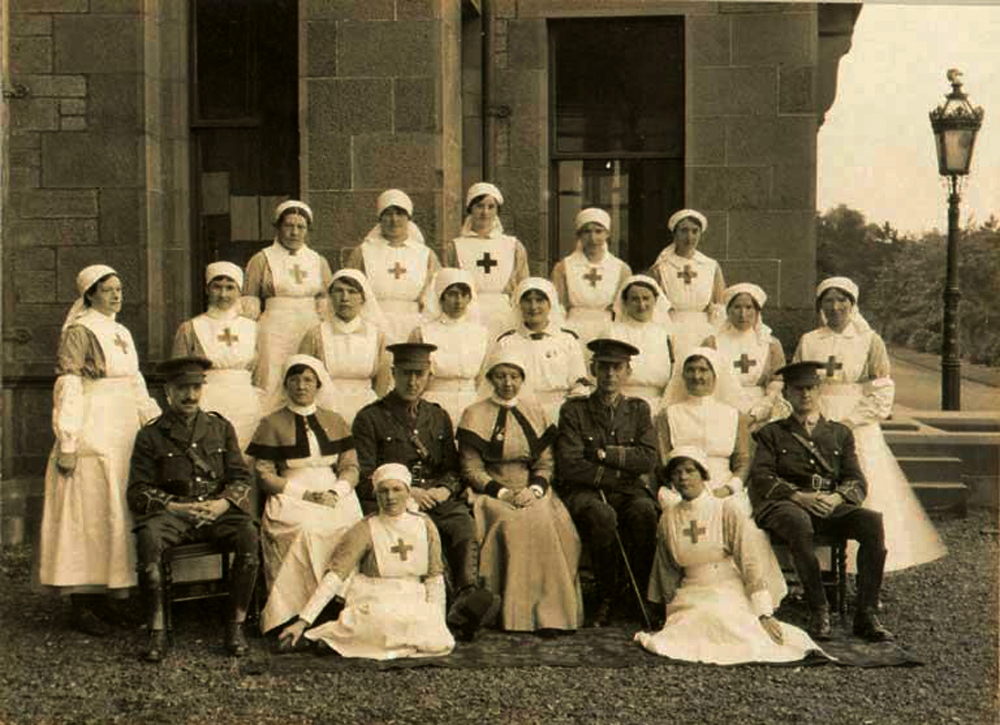Arthur John Brock
Arthur John Brock 1879-1947
The little known story of one of North Queensferry’s former residents
The Hydra, Captain AJ Brock and the Treatment of Shell-Shock in Edinburgh 1917/18
Arthur John Brock was born in 1879 in Overton, near Edinburgh, the son of a gentleman farmer and Florence Walker, a poet. Brock initially studied classics, graduating from the Faculty of Arts at the University of Edinburgh in 1894. He wanted to be an artist, but his father forbade it, so Brock returned to the University in 1896 to begin medical training, after a brief period in Vienna and Berlin, qualified in 1901 and became an MD 4 years later.
Whilst Brock was a medical student, he came under the influence of Patrick Geddes, a celebrated local sociologist and scientist. Officially a professor of botany at Dundee but in practice he was a zoologist, publisher and town planner with the Outlook Tower and buildings close by the Edinburgh Castle esplanade being his best known legacy.
In August 1915 he married Siri Marianne von Nolting from Sweden who herself was a noted physiotherapist. In the same year he joined the Royal Army Medical Corps and in !917 was transferred to Craiglockhart as one of 4 medical officers.
Introduction
In the first few weeks of July 1916, during the Battle of the Somme, the problem that ‘shell-shock’ posed to the British Expeditionary Force became acute. According to the official history records, ‘several thousand soldiers were rapidly passed out of the battle zone on account of nervous disorders and many of them were evacuated to England’. A rapid expansion in medical services was necessary to deal with these patients, and it was at this time that the War Office took over Craiglockhart Hydropathic in Edinburgh for the treatment of shell shocked officers.
Craiglockhart War Hospital has become famous due to its association with several remarkable individuals. The poet Siegfried Sassoon, who was sent to Craiglockhart in 1917 after refusing to serve further in a war he considered unjust, wrote about the hospital in his memoir Sherston’s Progress. Sassoon was under the care of Captain WHR Rivers, an outstanding shell-shock doctor, anthropologist and psychologist.
It appears, however, that there were other, sociological aspects to therapy at Craiglockhart, especially around one of the other medical officers, Captain AJ Brock. It is well known by literary scholars that one of Brock’s patients was Wilfred Owen. The hospital magazine Hydra was launched in April 1917 illustrating Brock’s approach to the treatment of shell-shock, taking its name from the many headed serpent slain by Hercules as one of his twelve labours. Wilfred Owen, was an editor and some of Owen’s and Sassoon’s poetry was first published in its pages. The ‘Hydra’ served as a journal of events in the house and the recognised mouthpiece of the various societies and clubs’. Thus, it provides a rich source of information about life at Craiglockhart War Hospital.
The first series of the magazine began on 28 April 1917, and ran fortnightly until 29 September 1917 (12 issues). The average length of these issues was 20 pages, of which eight contained advertisements (for businesses such as jewellers, photographers, cigarette manufacturers, tailors and sports outfitters), with the rest dedicated to submitted poetry, prose and drawings, as well as news, hospital events and an editorial.
Captain Brock and Ergotherapy
Of the four medical officers at Craiglockart (Captain Rivers, Captain Brock, the American Major Ruggles and the Commanding Officer Major Bryce), it is Brock’s name which appears by far the most frequently in The Hydra – both in relation to various societies in the Hospital, and as the contributor of several articles. His support is recognised in one of the later editorials: ‘Captain Brock has always proved to be a staunch friend of the Field Club and The Hydra.’
There are a few photographs of the medical officers, hospital and members of the Officers’ Club. The only surviving run of the magazine is housed at the University of Oxford English Faculty Library (Wilfred Owen Collection); the National Library of Scotland has Xerox copies of this run. The collection is missing numbers 4–6 of the New Series (i.e. February to April 1918).
 Captain Arthur J Brock, Medical Officer
Captain Arthur J Brock, Medical Officer
The Hospital as a Therapeutic Community
Therapeutic benefits were claimed by The Hydra for many of the activities on offer at Craiglockhart; for example badminton: ‘continue to Let the shuttle weave health and strength into our tired muscles’. The Hydra encouraged Craiglockhart patients to engage in life. Such encouragement was not provided at all shellshock hospitals. The first patients brought back to Britain had been treated with the Weir Mitchell cure of isolation, rest, massage, and a milk diet, and conventionally-minded medical officers encouraged patients to ‘put it out of your mind, old boy’. ‘The advice which has usually been given to my patients in other hospitals,’ wrote Rivers, ‘is that they should endeavour to banish all thoughts of the war from their minds . . . and lead their thoughts to other topics, beautiful scenery and other pleasant aspects of experience’.
Patients were not allowed to discuss their experiences among themselves or with visitors, an approach which helped to maintain the credibility of home front propaganda. Rivers, however, recognised that repression of traumatic memories resulted in perpetuating and fixing neuroses. He found that when his patients allowed their minds to dwell on their experiences during the day, they were no longer disturbed at night by terrifying dreams. This advice appealed to Brock’s philosophy of facing up to life. ‘In the powerful war-poems of Wilfred Owen,’ he wrote, ‘we read the heroic testimony of one who . . . in the most literal sense “faced the phantoms of the mind”.
The ‘ancient and honourable’ game of golf receives glowing recommendations: ‘How much more beneficial it is for patients to play even once round the course daily . . . than to be perpetually immured in a picture house, or to parade Princes Street for the gratification of their own vanity’. Perhaps interest might be stimulated in this great health-giving national game, and the result would be advantageous to the patients, morally and physically.’
Conclusion
For what future did Craiglockhart rehabilitate patients? Although Brock was professionally obliged, as a commissioned army psychiatrist, to return officers to active service, he found this ‘one of the very hardest things that a doctor had to do’. To some extent, Brock seems to have been preparing his patients for life after the war. His methods might even be viewed as an early form of occupational therapy. The Field Club, for example, aimed to be: the first step towards the future employment of officers in work for which they possess special aptitude. We have had already in this war too much of the ‘square peg in a round hole’ policy, and there is no reason why has at length come . . . at no time was mankind in a better position to become master of its fate’. Craiglockhart was Brock’s model of how future society should be. ‘Après la guerre we expect to see all our Craiglockhart farming enthusiasts at least Heads of Department for the resettlement and reorganisation of the countryside!’. In summary, this study revealed a little-studied aspect of the treatment of shell-shock – that of a therapeutic community. The method employed, i.e. analysis of a hospital magazine, may seem an unusual way of investigating therapeutics. It has, however, proved we, at Craiglockhart, should not be preparing for a more enlightened policy. For Brock, neurasthenia was a condition with a social cause.
The end of 2020 marked the 100th anniversary of the posthumous publication of Wilfred Owen’s war poems. Many of them were written in late 1917 when he was a “shell shock patient” in Edinburgh’s Craiglockhart War Hospital. Without Craiglockhart and the care of Edinburgh doctor, Arthur John Brock, we may never have read Owen’s words on “the pity of war.” A century on, Brock’s “ergotherapy” may have resonance and applicability as the covid-19 pandemic takes its toll on many people’s mental health.
Arthur Brock, like his mentor Patrick Geddes, was a polymath; his interests were wide ranging and included biology, botany, geography, local history and Greek antiquaries. After the war in 1925 Dr Brock moved to Garthhill in North Queensferry, where he used his house as a surgery/cottage hospital, helping World War I veterans and others distressed by mental trauma. Brock also did much for the local community through the North Queensferry Development Association. In recognition of his legacy Brock Street was named after him.
Sources: AM Crossman, final-year medical student, University of Edinburgh and the British Medical Journal published 10/12/2020
Doctor Brock at Craiglockhart War Hospital

In this photograph of the staff and patients at Craiglockhart War Hospital, we can see some of the Officers who were sent to Craiglockhart to be treated for shell-shock. In the front row of the photograph, Dr Arthur Brock is seated six from the right, and Dr William Rivers is seated six from the left.
Seated to the right of Dr Rivers is Matron Marjorie McBean, Matron of the War Hospital. Dr William Bryce is seated to the right of Matron McBean. All Doctors were well respected pioneers in the treatment of shell-shock. Note the two nurses seated at the fifth window from the right on the top floor of the hospital.

This photograph of the nursing and medical staff at Craiglockhart War Hospital gives us a rare glimpse of the staff who were charged with caring for shell-shocked officers during World War One. Dr Arthur Brock is seated third from the right and Dr William Bryce third from the left, in the second row.
At the outbreak of war, in 1914, there were two uniformed services open to women: the First Aid Nursing Yeomanry and the Voluntary Aid Detachments. Both organisations were perceived to recruit only from the upper and middle classes. The Matron, Miss Marjorie McBean is seated between the two doctors.
Many of these nurses would have led very sheltered lives prior to the war, and the conditions of soldiers returning from the front would have been most disturbing to them.